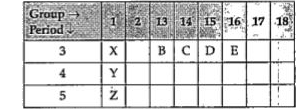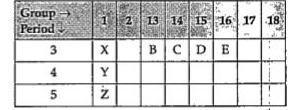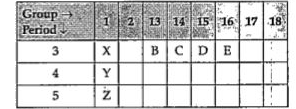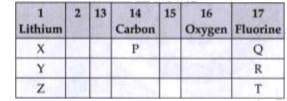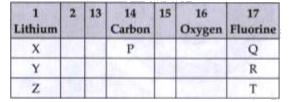CASE - BASED MCQs from OSWAL PUBLICATION PERIODIC CLASSIFICATION OF ELEMENTS for Class 10
| Class 10 | CHEMISTRY |
| Chapter | PERIODIC CLASSIFICATION OF ELEMENTS |
| OSWAL PUBLICATION | CASE - BASED MCQs |
| Medium | English |
| Academic Year | 2023-2024 |
Question 1
Mendeleev was a Russian chemist, who contributed the most for the development of periodic table of elements wherein the elements were arranged on the basis of their fundamental property, the atomic mass and also on the similarity of chemical properties. Only 63 elements were known at his time. He arranged the 63 elements in the increasing order of their atomic masses and found that there was a periodic recurrence of elements with similar physical and chemical properties, He observed that elements with similar properties fall in the same vertical column. These vertical columns are called groups and horizontal rows of elements are called periods. Mendeleev predicted the existence of certain elements not known at that time and named two of them as Eka-silicon and Eka-aluminium.
Mendeleev arranged the periodic table on the basis of their fundamental property: View SolutionQuestion 2
Mendeleev was a Russian chemist, who contributed the most for the development of periodic table of elements wherein the elements were arranged on the basis of their fundamental property, the atomic mass and also on the similarity of chemical properties. Only 63 elements were known at his time. He arranged the 63 elements in the increasing order of their atomic masses and found that there was a periodic recurrence of elements with similar physical and chemical properties, He observed that elements with similar properties fall in the same vertical column. These vertical columns are called groups and horizontal rows of elements are called periods. Mendeleev predicted the existence of certain elements not known at that time and named two of them as Eka-silicon and Eka-aluminium.
Eka aluminium and eka silicon were later replaced respectively as : View SolutionQuestion 3
Mendeleev was a Russian chemist, who contributed the most for the development of periodic table of elements wherein the elements were arranged on the basis of their fundamental property, the atomic mass and also on the similarity of chemical properties. Only 63 elements were known at his time. He arranged the 63 elements in the increasing order of their atomic masses and found that there was a periodic recurrence of elements with similar physical and chemical properties, He observed that elements with similar properties fall in the same vertical column. These vertical columns are called groups and horizontal rows of elements are called periods. Mendeleev predicted the existence of certain elements not known at that time and named two of them as Eka-silicon and Eka-aluminium.
The elements eka aluminium and eka silicon discovered by Mendeleev later found place in periodic table. Both of these elements belong to: View SolutionQuestion 4
Mendeleev was a Russian chemist, who contributed the most for the development of periodic table of elements wherein the elements were arranged on the basis of their fundamental property, the atomic mass and also on the similarity of chemical properties. Only 63 elements were known at his time. He arranged the 63 elements in the increasing order of their atomic masses and found that there was a periodic recurrence of elements with similar physical and chemical properties, He observed that elements with similar properties fall in the same vertical column. These vertical columns are called groups and horizontal rows of elements are called periods. Mendeleev predicted the existence of certain elements not known at that time and named two of them as Eka-silicon and Eka-aluminium.
Mendeleev's periodic table has: View SolutionQuestion 5
Mendeleev was a Russian chemist, who contributed the most for the development of periodic table of elements wherein the elements were arranged on the basis of their fundamental property, the atomic mass and also on the similarity of chemical properties. Only 63 elements were known at his time. He arranged the 63 elements in the increasing order of their atomic masses and found that there was a periodic recurrence of elements with similar physical and chemical properties, He observed that elements with similar properties fall in the same vertical column. These vertical columns are called groups and horizontal rows of elements are called periods. Mendeleev predicted the existence of certain elements not known at that time and named two of them as Eka-silicon and Eka-aluminium.
How do we classify these newly discovered elements (eka-aluminium and eka-silicon)? View SolutionQuestion 11
Atoms of eight elements A, B, C, D, E, F, G and H have the same number of electronic shells but are different in their outermost shells. It was found that elements A and G combine to form an ionic compound which can also be extracted from sea water. Oxides of the elements A and B are basic in nature while those of E and F are acidic. The oxide of elements D is almost neutral.
Which of the following is likely to be halogen? View SolutionQuestion 12
Atoms of eight elements A, B, C, D, E, F, G and H have the same number of electronic shells but are different in their outermost shells. It was found that elements A and G combine to form an ionic compound which can also be extracted from sea water. Oxides of the elements A and B are basic in nature while those of E and F are acidic. The oxide of elements D is almost neutral.
Which one of the following elements is likely to be a noble gas? View SolutionQuestion 13
Atoms of eight elements A, B, C, D, E, F, G and H have the same number of electronic shells but are different number of electrons in their outermost shells. It was found that elements A and G combine to form an ionic compound which can also be extracted from sea water. Oxides of the elements A and B are basic in nature while those of E and F are acidic. The oxide of elements D is almost neutral.
Which two elements amongst these are likely to be the non-metals ? View SolutionQuestion 14
Atoms of eight elements A, B, C, D, E, F, G and H have the same number of electronic shells but are different in their outermost shells. It was found that elements A and G combine to form an ionic compound which can also be extracted from sea water. Oxides of the elements A and B are basic in nature while those of E and F are acidic. The oxide of elements D is almost neutral.
Which one of the following will have largest atomic radii?View SolutionQuestion 15
Atoms of eight elements A, B, C, D, E, F, G and H have the same number of electronic shells but are different in their outermost shells. It was found that elements A and G combine to form an ionic compound which can also be extracted from sea water. Oxides of the elements A and B are basic in nature while those of E and F are acidic. The oxide of elements D is almost neutral.
To which period the listed elements belong?View Solution
All Exercises from OSWAL PUBLICATION Class 10 CHEMISTRY PERIODIC CLASSIFICATION OF ELEMENTS
- MULTIPLE CHOICE QUESTIONS
- SELF - ASSESSMENT - 1 ( OBJECTIVE TYPE QUESTIONS)
- STAND ALONE MCQS
- ASSERTION AND REASON BASED MCQS
- CASE BASED QUESTIONS
- SELF - ASSESSMENT - 2 ( OBJECTIVE TYPE QUESTIONS)
- CASE - BASED MCQS
- NCERT CORNER (EXERCISE QUESTIONS)
- NCERT CORNER (INTEXT CORNER)
- REASONING BASED QUESTIONS
- NCERT EXEMPLAR (LONG ANSWER QUESTIONS)
- NCERT EXEMPLAR (MULTIPLE CHOICE QUESTIONS)
- NCERT EXEMPLAR (SHORT ANSWER QUESTIONS)
- VERY SHORT ANSWER TYPE QUESTIONS
- BOARD CORNER (LONG ANSWER TYPE QUESTIONS)
- BOARD CORNER (SHORT ANSWER TYPE QUESTIONS)
- SHORT ANSWER TYPE QUESTIONS
- LONG ANSWER TYPE QUESTIONS
- DIFFERENTIATE BETWEEN
- ANALYSIS AND EVALUATION BASED QUESTIONS
- CREATING BASED QUESTIONS
- SELF - ASSESSMENT



